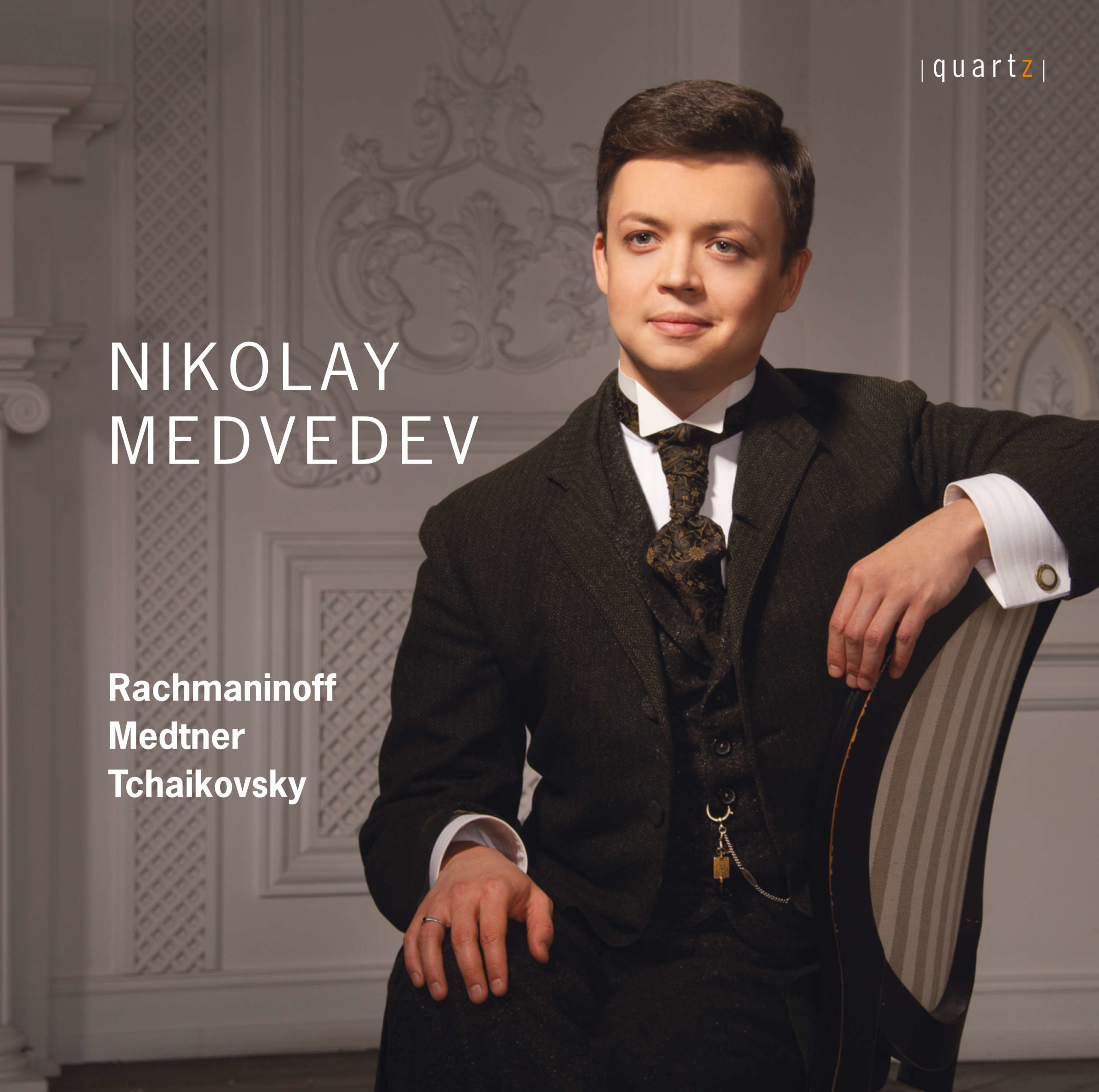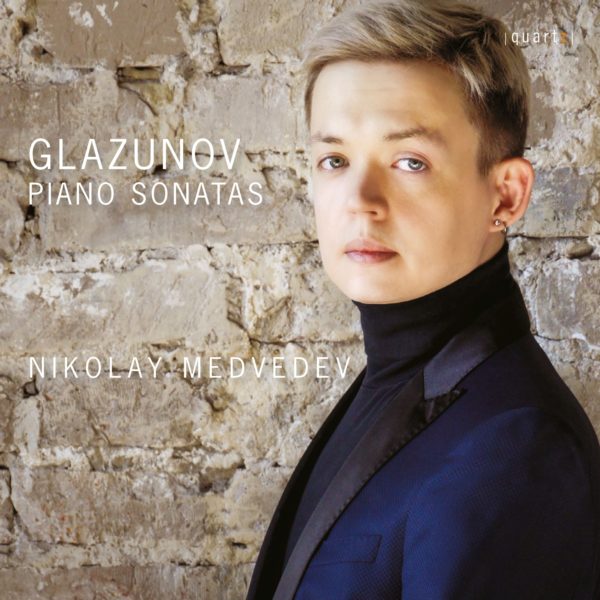Rachmaninoff, Medtner & Tchaikovsky
£7.99 – £16.99
Interviewed by Musical America in 1921, Rachmaninoff was asked: “would you agree that the heart should be the composer’s guide through the labyrinths of accepted forms?” “Yes”, he replied, “the heart above all. Of course, the head must aid in the building of great musical structures, but by itself the head is impotent. If a composer is devoid of heart or hasn’t his heart in the right place, it is impossible for him to conceal his deficiency. This explains why Russian music is so superlatively great; it speaks so directly to the heart. That is what gives it its vital beauty, its universality of appeal, and thus all great art is universal and national in character– it were better to say local instead of national – at one and the same moment.” It is perhaps for this reason that young pianist Nikolay Medvedev has chosen a program of Russian piano masterpieces for his debut album.
About This Recording
Interviewed by Musical America in 1921, Rachmaninoff was asked: “would you agree that the heart should be the composer’s guide through the labyrinths of accepted forms?”
“Yes”, he replied, “the heart above all. Of course, the head must aid in the building of great musical structures, but by itself the head is impotent. If a composer is devoid of heart or hasn’t his heart in the right place, it is impossible for him to conceal his deficiency. This explains why Russian music is so superlatively great; it speaks so directly to the heart. That is what gives it its vital beauty, its universality of appeal, and thus all great art is universal and national in character—it were better to say local instead of national—at one and the same moment.”
One hundred years ago, Rachmaninoff was regarded as the living embodiment of the characteristics he espoused in Russian music, although by 1921 of course, the early works of Stravinsky and Prokofiev had appeared, exemplars of new approaches to composition which spoke less directly to the heart. For composers of Rachmaninoff’s generation, under the shadow of Tchaikovsky and others of his era, the expression of emotional characteristics and feeling was their prime motivation.
Tchaikovsky, who had died suddenly aged 53 in 1893, had expressed those characteristics in abundance, as the popularity of his symphonies, concertos, ballet music and operas shows, but it may initially strike one as curious that his music in other genres remains relatively unknown.
This is not to imply that Tchaikovsky’s output in song, chamber music and piano music was comparatively insignificant, for one can cite undoubted masterpieces in each genre, but it appears that – away from the concert hall and opera house – his music has continued to suffer from a relatively (albeit only relatively) unwarranted neglect that has nothing to do with the quality of the music itself, but which – in the specific case of his solo piano music – owes more to a perceived reputation that he was, in some way, somewhat uncertain technically with regard to writing for the piano.
Yet Tchaikovsky was at the very least a passable pianist. He may not have reached the standard of giving public recitals – as his contemporaries Anton Rubinstein, Siloti and, later, Rachmaninoff did – but, apart from his self-consciousness at appearing publicly (though he overcame his nervousness and conducted relatively regularly, notably during his American tour in 1891), he played the piano daily, and more than knew his way around the instrument, as his Concertos in B flat minor and G major attest. The enormous popularity of the first of those works and the increase in appreciation of the second in recent decades demonstrate that Tchaikovsky’s piano music could hardly have been conceived for other than the keyboard. It may be true that Tchaikovsky’s piano writing is individual, but of which great composer who left a significant body of music for the instrument can that not be said?
Tchaikovsky’s Grande Sonate in G major, his Opus 37, was published during his lifetime, having been written in 1878. The Sonata is dedicated to the great German musical polymath Karl Klindworth – a fine pianist (pupil of Liszt), conductor, composer, editor – to whom Tchaikovsky has previously dedicated his Capriccio (Opus 8), composed in 1870. The Capriccio is one of a relatively extensive collection of shorter pieces for solo piano which occupied Tchaikovsky throughout his composing life – from the two pieces designated as his Opus 1 in 1867 to the 18 Morceaux which constitute his Opus 72, written 25 years later.
Tchaikovsky’s most significant work for solo piano, the large-scale – hence ‘Grande’ – Sonata in G major, is contemporaneous with other of his solo piano works – the twelve-movement suite The Months, sometimes called The Seasons, and a delightful set of short piano pieces for children. The Sonata followed directly from the Fourth Symphony of the previous year and almost immediately preceded the choral Liturgy of St John of Chrysostom Opus 41.
The spectacular advance in compositional mastery which the Fourth Symphony represented did much to bolster Tchaikovsky’s self-confidence, as his correspondence at the time reveals. Equally clearly, by the time he came to write the Sonata for Klindworth Tchaikovsky’s inspiration was running high: the work opens with a magnificent chordal gesture (the inherent nobility of which has sometimes led to the word ‘Imperial’ being applied to Tchaikovsky’s works in G major – witness the soon-to-be-composed Second Concerto, the music of which was, much later, utilised by Balanchine for his ‘Ballet Imperial’).
The Sonata’s initial theme has considerable importance throughout the work – elements, which are by no means immediately apparent, are threaded through and across all four movements in a way that analysis reveals is an impressive creative achievement. Of course, it is not Tchaikovsky’s new-found organic mastery that makes the Sonata so immediately impressive: the opening gesture commands attention, to the point where it is only later that we realise what a wealth of invention it opens up. The wonderfully lyrical second subject is not only a great contrast: it also contains the rhythmic core of the first few bars; here is symphonic unity, as natural as breathing, and the treatment those contrasting yet unified ideas are given sustain this extensive movement – yet not before a reference, surely deliberate, to the plainsong Dies Irae (was Tchaikovsky’s Opus 41 already beginning to form in his mind?).
The character of the slow movement is impressive: here is mood-painting, a secret, perhaps, to the composer alone, through which he creates a scene of almost theatrical character, contrasted by way of new ideas, related once more to the Sonata’s opening dotted rhythm, but here displayed afresh before a big climax leads to a quietly expressive coda.
The Scherzo and finale exhibit new facets of elements from the earlier movements – here is further evidence of masterful creativity, the mood and temperament of the individual passages entirely characteristic of Tchaikovsky at the very height of his powers.
As a young composer, Rachmaninoff’s qualities were recognised by Tchaikovsky, who did much to encourage him in several practical ways. On the evening of the announcement of Tchaikovsky’s sudden death, in November 1893, Rachmaninoff began a Piano Trio (Trio élégiaque Op 9, his second work with that title), dedicated to his memory. Although Rachmaninoff came to be generally regarded (and correctly, during his maturity) as a pianist-composer, the six Moments Musicaux of 1896 constitute only his third work for solo piano, in marked contrast to the output of Chopin, Schumann, Liszt or Brahms. When Rachmaninoff’s Opus 16 appeared, virtually every home with a pretention to culture possessed a piano, and at least one family member could play to a secure standard. The composition and publication of groups of genre pieces – the modern equivalent of keyboard suites by baroque composers – was a common event, by no means the rare event of a century and more later. Rachmaninoff’s Opus 16 was also the 23-year-old composer’s third collection of genre pieces, following the appearance of the greatest expression of his early maturity, his first Symphony, Opus 13. With the Symphony behind him (the work’s disastrous premiere under Glazunov was a few months away), Rachmaninoff flexed his muscles in this set of piano pieces.
The opening piece, in B flat minor, possesses a haunting theme. Apparently chromatic and gently syncopated, it is in fact diatonic, the initial minor sixth leading to a major scale over triple minor sixths. The effect is magical, almost improvisatory, and – as the Moments Musicaux progress – is subtly revealed as a ‘motto’ theme for the whole set, and is much varied, even within this opening piece. The second piece, Allegro, is genuinely and brilliantly chromatic, a true virtuoso item demanding a very supple right hand from the pianist. The moto perpetuo character is thrown into sharp relief by the third piece, an introspective reverie, very slow, perhaps the most subtly Russian of the six, a slow variation possessing the character of a brown study. In the fourth piece, Presto, the chromaticism is confined to the flying left-hand sextuplets against a rising quasi-military idea whose opening sixth inverts the ‘motto’ and contrasts with a descending scalic theme. The contemplative Adagio sostenuto in D flat hides the theme in the accompanying counterpoint, before the surrebounding final piece surgerr on its majestic way with the theme intricately woven into florid passage-work which analysis reveals as the haunting ‘motto’, transformed into grandeur.
Three years after Rachmaninoff’s interview with Musical America, the French-born critic M.D. Calvorcoressi said of Nicholas Medtner “He is one of the chief exponents in Russia of the traditional classical tendency, and his music owes nothing to the influence either of the Nationalist movement or of more modern tendencies, such as Scriabin’s”. Medtner was not alone: born in Moscow in 1879, his life – as was Rachmaninoff’s – had been turned on its head as a consequence of the Bolshevik Revolution in 1917, which obliged him a few years later to abandon his professorship of piano at the Moscow Conservatoire and seek a new life abroad. His fate, in that regard, was not entirely dissimilar to that of his close friend Rachmaninoff, who later told Medtner that he regarded him as the greatest living composer.
With three piano concertos, many songs and some chamber music, Medtner, like Chopin, composed exclusively for the piano, and also – like Rachmaninoff his piano music ranges quite widely, from short character-studies to larger-scaled sonatas, of which one of the finest examples is the Sonata in G minor Opus 22, composed in 1910.
It is superbly laid out for the instrument and falls into four distinct, yet continuous, sections: Tenebroso, sempre affretando – Allegro assai – Interludium (Andante lugubre) – Allegro assai. Although these sections are self-evident, Medtner displays a sense of unity throughout that borders on genius, as the composer’s organic mastery enables these varying moods to succeed one another with an undoubted sense of inevitability, the emotional structure of the Sonata compelling attention from the listener.
Robert Matthew-Walker © 2021
Track Listing
- I. Andantino in B flat minor
- II. Allegretto in E flat minor
- III. Andante cantabile in B minor
- IV. Presto in E minor
- V. Adagio sostenuto in Dflat major
- VI. Maestoso in C major
- Piano Sonata in G minor, Op.22
- I. Moderato e risoluto in G major
- II. Andante non troppo quasi Moderato in E minor
- III. Scherzo. Allegro giocoso in G major
- IV. Finale. Allegro vivace in G major
RACHMANINOFF: Six Moments Musicaux Opus 16
MEDTNER: Sonata in G minor Opus 22
TCHAIKOVSKY: Grand Sonata in G major Opus 37

